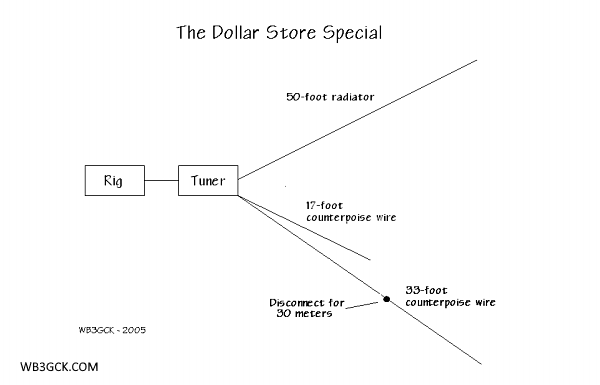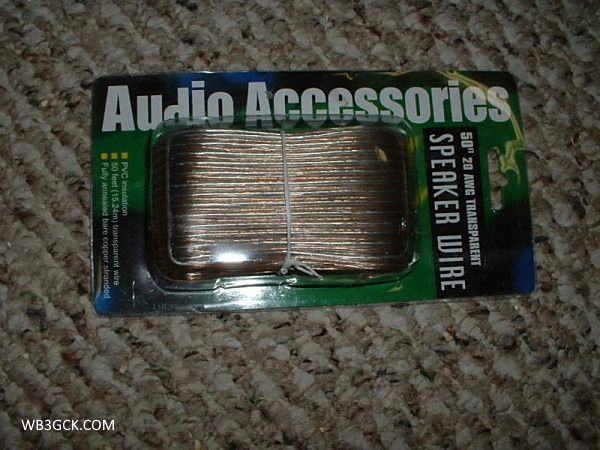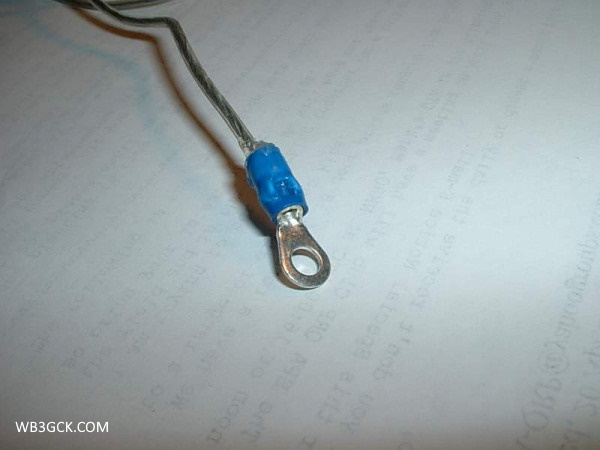[NOTE: This is an updated version of an old article from my QSL.NET website. In the interest of full disclosure: My local dollar store no longer sells the speaker wire I used. While it’ll probably cost you a few more bucks to build one, it’ll still be a cheap antenna. Although the original article has been on my website for 15 years, I still get the occasional email from folks who have built one.]
I love rummaging through our local dollar store. One of the biggest bargains in our local dollar store is speaker wire. You can get 50 feet of two-conductor speaker wire for a buck. Not too shabby. I always keep a bunch of the stuff on hand for antenna experimentation.

Using a single 50-foot roll of dollar store speaker wire, I made a simple 50-foot random wire antenna with counterpoise wires to cover the 40, 30 and 20-meter bands. I stashed the whole kit in a zip-lock sandwich bag and always keep it on hand as a backup antenna system whenever I operate in the field. With a simple antenna tuner of some sort, this will get you on the air in a pinch, should your primary antenna fail.

Here’s all you have to do:
- Separate the conductors so that you now have two separate 50-foot wires.
- For the radiator, take one of the 50-foot wires and crimp a small ring lug to one end—right over the insulation. This gives you someplace to tie a line to hoist it up. On the other end, just strip off a half-inch or so of the insulation. You can leave it bare or add whatever kind of connector you want; whatever works best with your tuner.
- For the counterpoise wires, take the remaining 50-foot wire and cut it so that you have a 33-foot wire and a 17-foot wire. If you only want to work 40 and 20 meters, you can stop right here. You now have counterpoise wires for both of these bands.
- To provide a counterpoise wire for 30 meters, take the 33-foot wire from Step #3 and cut it so that you now have a 23-foot wire and a 10-foot wire. Strip off about 1/2-inch of insulation from one end of the 23-foot wire. Install a quick-disconnect connector of some sort on the other end, so that you can join the 23-foot and 10-foot wire sections together. The idea here is that, with the two wires connected, you have a 33-foot counterpoise wire for 40 meters. With the two sections separated, you now have a 23-foot counterpoise wire for 30 meters.


[Note: If you only plan to operate with the radials laying on the ground, cutting them to resonance isn’t too important. You can simplify things a bit by going with just the 33 and 16-foot wires. I think two 25-foot wires would be sufficient, as well. Three 16.6-ft radials is another option to consider. Feel free to experiment here and see what works for you.]
In operation, just hoist one end of the 50-foot radiator up in a tree or other suitable support. Connect the other end to the hot side of your tuner. Connect the 33-foot and 17-foot counterpoise wires to the ground connection on your tuner and lay them out on the ground. When you want to work 30 meters, just disconnect the quick-disconnect on the longer counterpoise wire. Pretty simple, eh? Any type of simple L-tuner should work fine for this.
Please note that I wouldn’t recommend using this wire for a permanent outdoor antenna. It’s not suited for that kind of use. But for temporary outdoor use, it’ll do just fine. Besides, if the wire goes bad, you can always replace the whole thing for a dollar!
73, Craig WB3GCK
©2005-2020 Craig LaBarge WB3GCK

hi there
I came across this antenna design whilst looking to get an antenna for CW
My name is Michael and I am a new ham. Recently licenced and I am looking fr an antenna that is simple to make, easy to make light, trail friendly and your design is perfect!!
If you could spare the time could you please give me a hand understanding the design of the antenna?
Here in the UK I am looking to work
20m
30m
And 40m
(I have an order placed for a mountain topper! Super excited!)
So just to understand
The frequencies here are
40m = 7.0-7.2 MHz
30m = 10.1 – 10.15 MHz
40m = 14.0 – 14.35 MHz
Could I please ask how you are coming to the lengths for radiating element and counterpoise?
I looked around and I could not find anything that seems to be close to what you are proposing
Could you please explain how you arrive at these numbers for
Radiating element and counterpoise?
I am thinking of making one of your ‘dollar specials’ and I want to understand the math behind that
Would the dimensions be the same of the 50 feet speaker wire was not a limitation?
If so could you please explain?
Many thanks, bets wishes and 73’s
Michael
MM7aJJ
LikeLike
Hi Michael:
There’s nothing magical about the radiator length. It’s a random (non-resonant) wire. As you guessed, I just used the 50-ft of available speaker wire. The three counterpoise segments were cut to be approximately a quarter-wavelength for the 40, 30, and 20-meter bands. Because this is a non-resonant antenna, you will definitely need to use an antenna tuner of some sort.
For your Mountain Topper, you might want to consider a resonant antenna to keep things simple. The jumpered dipoles from SOTABeams in the UK are an example.
It would be fairly easy to build your own and save some money in the process.
I hope this helps. Thanks for stopping by. Best of luck with your Mountain Topper when you get it.
73, Craig WB3GCK
LikeLike
thank you Craig!
this is so helpful
many thanks for clarifying!
ok then for
Radiating element – I will use the Packtenna Mini recommended ones
“Antenna Wire Length Use one of the following lengths: 29’ 35.5’ 41’ 58’ 71’”
so it will be 58 feet
for Counterpoises I will go with
40m = 7.0-7.2 MHz >>> 32.92ft
30m = 10.1 – 10.15 MHz >>> 23.9ft
40m = 14.0 – 14.35 MHz >>> 16.52ft
I will be making them from simple wire – so any length really I can do
(no need to retain the overall 50ft measurements)
as my math is.. well… basic…
does that sound like an ok plan to you?
and am I right that you deploy that in a sloper configuration?
(or is that as versatile as any wire antenna?)
thank you for taking the Time Craig – much appreciated
if that works I will call it the ‘One Dollar Store Craig Special’
LikeLike
Any of the wire lengths should work for you, provided that you use an antenna tuner of some sort. Otherwise, you risk damaging your Mountain Topper.
Best of luck!
73, Craig WB3GCK
LikeLike